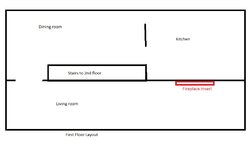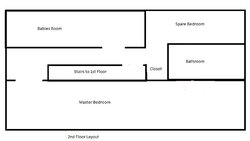I'm wondering the best way to move the heat around my house. I have a Lopi Freedom fireplace insert with the blower in my living room. The house is approximately 2000 sqft and is 2 floors. I have attached a rough sketch of the floor plan (excuse my poor MS Paint skills!). The stove room is about 10'x30' with only one doorway into the room. Last winter I experimented with fans on the floor, pulling cold air in and blowing warm air out trying to get the heat to the other rooms of the house, all with varying results. . The master bedroom is above the fireplace room so the bedroom was fairly warm for us. However, we just had a baby on Sept. 11, so I'm going to need to keep the upstairs a lot warmer this winter. My other heat source is an oil forced hot air furnace and the only zone is on the first floor which stays pretty warm so the furnace doesn't come on often.
So what do you guys think, what are some options to get the heat to move throughout the house and to the second floor?


So what do you guys think, what are some options to get the heat to move throughout the house and to the second floor?


Last edited by a moderator:


